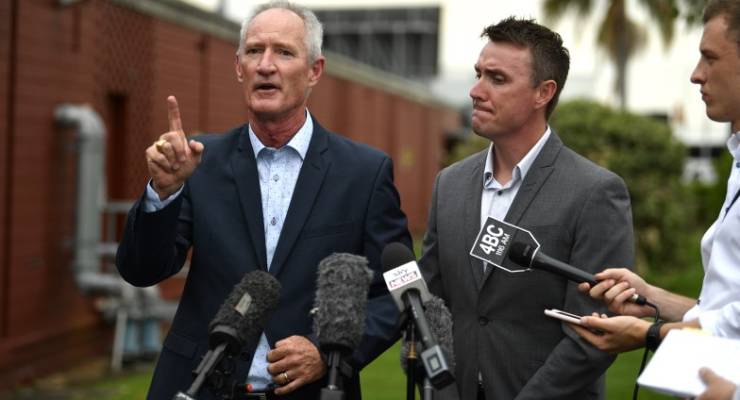
Yesterday, Al Jazeera dropped the bombshell that One Nation had been lobbying the National Rifle Association for donations, seemingly in return for watering-down Australia’s gun laws.
The scoop was the result of journalist Rodger Muller spending three years of his life infiltrating the NRA. Muller created and posed as the founder of “Gun Rights Australia”, an pro-gun group railing against the country’s gun restrictions, attending events and meetings equipped with hidden cameras:
My job was to use this as a front to endear myself to NRA officials and climb as high as I could within the organisation, recording conversations with them on subjects such as how they respond to a massacre, how they pressure members of the US Congress, and how they manipulate the media.
The story has the potential to echo all the way to the upcoming federal election. Crikey takes a look at how to pull off a successful sting, the risks, and a few instances that didn’t work out so well.
Double lives and anonymity
Al Jazeera flew me to London, where I was taught how to phrase questions and how to conduct myself as an undercover journalist … And they brought me to the US and put me through gun safety courses and arms training. My new life as a “gun enthusiast” had begun.
Muller has written about having to subsume all his actual beliefs into a persona that embodied the opposite. Indeed, Muller’s ruse as gun lobbyist was successful enough that people would apparently stop him on the street to confront him on his pro-gun stance.
Anonymity following a sting is often a necessity, particularly if it implicates the powerful. One the world’s great undercover journalists, Ghanaian Anas Aremeyaw Anas, produced often explosive material about crime and corruption in his home country over 20 years. In recent years he has gained international acclaim for “Ghana in the eyes of God” — the result of more than 500 hours of hidden-camera footage. It exposed rampant corruption in Ghana’s judicial system: judges and other officials taking bribes, demanding sex in exchange for legal favours and more.
As a result, 20 of Ghana’s highest justices and magistrates were dismissed. Anas maintains strict anonymity; in any public appearance he hides his face in a theatrical manner that wouldn’t disgrace musician Sia; he performed a TED talk in 2013, covering his face with woven wool.
Commitment
Possibly the defining (certainly the pioneering) achievement of undercover journalism is Ten Days in The Mad House by Nellie Bly (pen-name of Elizabeth Cochran Seaman) who in 1887 agreed to feign insanity to investigate allegations of brutality and neglect at the Women’s Lunatic Asylum on Blackwell’s Island for New York World. She did so knowing something of the hardships, and the difficulties she would face getting out:
“How will you get me out,” I asked my editor, “after I once get in?”
“I do not know,” he replied, ‘but we will get you out if we have to tell who you are, and for what purpose you feigned insanity — only to get in.”
I had little belief in my ability to deceive the insanity experts, and I think my editor had less.
After checking into a boarding house, she acted “crazy” long enough for them to summon the police, she was taken to a court house, pronounced “insane” by a judge and then several doctors (“positively demented,” was how one put it). She was taken to Blackwell’s, “an insane place”, one ambulance driver told her, “where you’ll never get out of”.
Bly experienced the awful conditions inflicted on mental institutions: the spoiled food, the undrinkable water, the dangerous patients bound together with ropes, the rat infestations, the abusive staff. Bly came to believe that some of her fellow patients were as “sane” as she was, and found, when she dropped her act, that it was impossible to convince her captors she was actually sane, until New York World sent an attorney to her aid.
The revelations of her piece led to greater funding for the asylum. Grand jury investigations into the abuses were mounted, nurses and physicians were fired and replaced, and immigrants who had been mistakenly committed had interpreters hired so they could make themselves understood.
Follow the story
What’s striking about the revelations of One Nation’s emissaries, is that they weren’t the primary target of the Muller investigation. The revelation that a minor party were trying to undo one of Australia’s least controversial policy successes of the past 30 years came about as a secondary point in looking into how the NRA attempts to mould public debate.
This highlights the fact that a journalist cannot go into a major story with too rigid an idea of what the story will ultimately be.
Know the risks
There has been talk about how Al Jazeera‘s sting interacts with the Media Entertainment and Arts Alliance code of ethics. Beyond that, One Nation have referred them to ASIO and the AFP for “interfering in Australian elections”. While the likelihood of legal ramifications for Al Jazeera seems low, stings do absolutely carry a risk.
Most famously ensnared was Mazher Mahmood (best known as the “Fake Sheikh”) who, over years working for News International had broken actual stories of sports corruption and many non-stories about alleged jihadists. Mahmood had long been accused of “debasing journalism”, but in 2016 his loose approach to journalistic ethics had more serious implications. In the aftermath of a 2014 drugs sting operation, then-X Factor judge Tulisa Contostavlos was put on trial. The trial fell apart and Mahmood was accused of perjury, and in 2016 he was found guilty of conspiracy to pervert the course of justice for altering evidence during his investigation. He was sentenced to 15 months jail.








“Blew the lid off”? Sounds like a thunderbox prank.
And again, thanks to Dick son for that heads-up into how the Newman government worked – from a minister in that government.
I guarantee that if Al Jazeera had done a sting to reveal an acive Jihadist nest the dopey duo of Ashby & Dickson would be toasting the broadcaster & replaying the footage with glee.
should read ‘active Jihadist nest’
One Nation have referred them to ASIO and the AFP for “interfering in Australian elections”.
Ha ! The NRA advised the One Nation officials to always go on the offensive !
The real question should be put to One Nation:
“Please explain?”
I have no problem at all with the Sting. One Nation in all their glory just got caught in the crossfire excuse the pun I am not a gun enthusiast I am a person trying to work for a peaceful world free from fear!! mission impossible! As far as Latham coming out saying that this kind of journalism is poisonous to democracy is quite remarkable considering the two henchmen were keen to get money to use it to ‘hold governments to ransom’ here. Maybe Latham should reflect before he speaks then he will have nothing to fear. I think this expose reveals the extent of NRA influence in US politics. I am proud that gun laws exist here in Australia that get up the NRA’s nose. No wonder there are no changes to gun laws in US. Thank you to brave journalists that were involved… I read recently that there were a number of people here in Australia that have quite a significant number of guns. Why??? If you can only use one at a time???
You know the answer to that. There is serious and sad psychology at work here.
What psychology makes people collect hundreds of guns? If this is a malaise then surely they need treatment and definitely not able to collect more guns Horrific.It has crossed my mind that given the gun owners in Mosman NSW and the wealth in that area that maybe…just maybe one could draw some conclusions that drugs or other activities have made these people very wealthy ?
Follow the money
Pot, kettle. Ashby has form himself in setting up Peter Slipper.
Exactly!